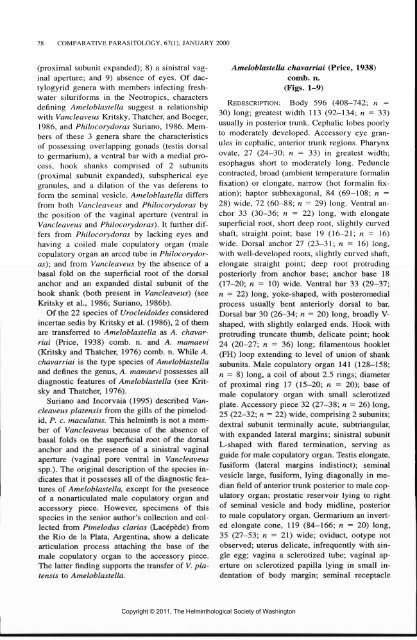Comparative Parasitology 67(1) 2000 - Peru State College
Comparative Parasitology 67(1) 2000 - Peru State College
Comparative Parasitology 67(1) 2000 - Peru State College
Create successful ePaper yourself
Turn your PDF publications into a flip-book with our unique Google optimized e-Paper software.
78 COMPARATIVE PARASITOLOGY, <strong>67</strong>(1), JANUARY <strong>2000</strong><br />
(proximal subunit expanded); 8) a sinistral vaginal<br />
aperture; and 9) absence of eyes. Of dactylogyrid<br />
genera with members infecting freshwater<br />
siluriforms in the Neotropics, characters<br />
defining Ameloblastella suggest a relationship<br />
with Vancleaveus Kritsky, Thatcher, and Boeger,<br />
1986, and Philocorydoras Suriano, 1986. Members<br />
of these 3 genera share the characteristics<br />
of possessing overlapping gonads (testis dorsal<br />
to germarium), a ventral bar with a medial process,<br />
hook shanks comprised of 2 subunits<br />
(proximal subunit expanded), subspherical eye<br />
granules, and a dilation of the vas deferens to<br />
form the seminal vesicle. Ameloblastella differs<br />
from both Vancleaveus and Philocotydoras by<br />
the position of the vaginal aperture (ventral in<br />
Vancleaveus and Philocorydoras). It further differs<br />
from Philocorydoras by lacking eyes and<br />
having a coiled male copulatory organ (male<br />
copulatory organ an arced tube in Philocorydoras)',<br />
and from Vancleaveus by the absence of a<br />
basal fold on the superficial root of the dorsal<br />
anchor and an expanded distal subunit of the<br />
hook shank (both present in Vancleaveus) (see<br />
Kritsky et al., 1986; Suriano, 1986b).<br />
Of the 22 species of Urocleidoides considered<br />
incertae sedis by Kritsky et al. (1986), 2 of them<br />
are transferred to Ameloblastella as A. chavarriai<br />
(Price, 1938) comb. n. and A. mamaevi<br />
(Kritsky and Thatcher, 1976) comb. n. While A.<br />
chavarriai is the type species of Ameloblastella<br />
and defines the genus, A. mamaevi possesses all<br />
diagnostic features of Ameloblastella (see Kritsky<br />
and Thatcher, 1976).<br />
Suriano and Incorvaia (1995) described Vancleaveus<br />
platensis from the gills of the pimelodid,<br />
P. c. maculatus. This helminth is not a member<br />
of Vancleaveus because of the absence of<br />
basal folds on the superficial root of the dorsal<br />
anchor and the presence of a sinistral vaginal<br />
aperture (vaginal pore ventral in Vancleaveus<br />
spp.). The original description of the species indicates<br />
that it possesses all of the diagnostic features<br />
of Ameloblastella, except for the presence<br />
of a nonarticulated male copulatory organ and<br />
accessory piece. However, specimens of this<br />
species in the senior author's collection and collected<br />
from Pimelodus clarias (Lacepede) from<br />
the Rio de la Plata, Argentina, show a delicate<br />
articulation process attaching the base of the<br />
male copulatory organ to the accessory piece.<br />
The latter finding supports the transfer of V. platensis<br />
to Ameloblastella.<br />
Copyright © 2011, The Helminthological Society of Washington<br />
Ameloblastella chavarriai (Price, 1938)<br />
comb. n.<br />
(Figs. 1-9)<br />
REDESCRIPTION: Body 596 (408-742; n =<br />
30) long; greatest width 113 (92-134; n = 33)<br />
usually in posterior trunk. Cephalic lobes poorly<br />
to moderately developed. Accessory eye granules<br />
in cephalic, anterior trunk regions. Pharynx<br />
ovate, 27 (24-30; n = 33) in greatest width;<br />
esophagus short to moderately long. Peduncle<br />
contracted, broad (ambient temperature formalin<br />
fixation) or elongate, narrow (hot formalin fixation);<br />
haptor subhexagonal, 84 (69-108; n =<br />
28) wide, 72 (60-88; n = 29) long. Ventral anchor<br />
33 (30-36; n = 22) long, with elongate<br />
superficial root, short deep root, slightly curved<br />
shaft, straight point; base 19 (16-21; n = 16)<br />
wide. Dorsal anchor 27 (23—31; n = 16) long,<br />
with well-developed roots, slightly curved shaft,<br />
elongate straight point; deep root protruding<br />
posteriorly from anchor base; anchor base 18<br />
(17-20; n = 10) wide. Ventral bar 33 (29-37;<br />
n = 22) long, yoke-shaped, with posteromedial<br />
process usually bent anteriorly dorsal to bar.<br />
Dorsal bar 30 (26-34; n = 20) long, broadly Vshaped,<br />
with slightly enlarged ends. Hook with<br />
protruding truncate thumb, delicate point; hook<br />
24 (20-27; n = 36) long; filamentous booklet<br />
(FH) loop extending to level of union of shank<br />
subunits. Male copulatory organ 141 (128-158;<br />
n = 8) long, a coil of about 2.5 rings; diameter<br />
of proximal ring 17 (15-20; n = 20); base of<br />
male copulatory organ with small sclerotized<br />
plate. Accessory piece 32 (27—38; n = 26) long,<br />
25 (22—32; n — 22) wide, comprising 2 subunits;<br />
dextral subunit terminally acute, subtriangular,<br />
with expanded lateral margins; sinistral subunit<br />
L-shaped with flared termination, serving as<br />
guide for male copulatory organ. Testis elongate,<br />
fusiform (lateral margins indistinct); seminal<br />
vesicle large, fusiform, lying diagonally in median<br />
field of anterior trunk posterior to male copulatory<br />
organ; prostatic reservoir lying to right<br />
of seminal vesicle and body midline, posterior<br />
to male copulatory organ. Germarium an inverted<br />
elongate cone, 119 (84-166; n = 20) long,<br />
35 (27—53; n = 21) wide; oviduct, ootype not<br />
observed; uterus delicate, infrequently with single<br />
egg; vagina a sclerotized tube; vaginal aperture<br />
on sclerotized papilla lying in small indentation<br />
of body margin; seminal receptacle
















